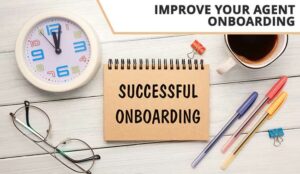NICE inContact share some best practices for onboarding new hires and creating first impressions that have a lasting impact.
It’s well established that the agent experience (AX) is a key component of any successful contact centre. A positive agent experience leads to increased engagement, promotes agent loyalty and reduces attrition – all of which have a long-term impact on the customer experience.
According to McKinsey, engaged and satisfied call centre agents are 8.5 times more likely to stay than leave within a year, and are 4 times more likely to stay than dissatisfied agents.
This retention rate is especially vital for small and medium-sized businesses (SMBs), where higher attrition requires greater investments in hiring and training, which eats into overall profits.
Indeed, the average cost of recruiting and training a new agent is around $12,000 in the US (source – ICMI) and £6,000-£9,000 in the UK (source – CIPD) – not to mention the value of the knowledge and expertise that is lost every time an agent leaves.
When thinking about the importance of AX, most contact centres tend to focus on supporting agents as they work. While this is of course an essential consideration, nurturing new hires actually starts before this point. In fact, it starts from their very first day in the office during the onboarding process.
Although onboarding new agents might seem like a fairly innocuous task in the grand scheme of things, it can have a significant impact on the long-term success of contact centres, especially SMBs.
New Agent, New Opportunity
The onboarding process is a rite of passage for any contact centre agent – one that can range from detailed training and induction programmes, to being thrown in at the deep end.
From the point of view of a new hire, the onboarding experience can be incredibly overwhelming. They’re being dropped into a completely new environment and tasked with getting up to speed with new people, processes, systems and cultures as quickly as possible.
If managed incorrectly, agents may start their role with a negative view of the company and lack the skills needed to effectively solve complex customer issues. The knock-on effect is that their engagement and the level of service they provide may be impacted, potentially leading to customer churn.
It will also make it harder to retain good employees, raising a contact centre’s cost of operations by increasing hiring and training costs.
When considering the onboarding process, companies must provide the right mix of training around contact centre processes, digital tools, customer service skills and the company’s brand promise to empower agents to deliver exceptional customer service from day one.
This also must feed into an agent’s ongoing training programme, which is particularly important in the current digital-first environment where agents are required to learn new skill sets and familiarize themselves with a range of different channels.
Ultimately, onboarding provides contact centres with an opportunity to mould new agents that aren’t yet encumbered by the organization’s day-to-day operations. So, what best practices should contact centres follow when onboarding new hires to ensure they make the process as easy and effective as possible?
Elevating Onboarding
Agent onboarding training typically emphasizes basics around tools and processes.
According to “The State of Experience and Engagement in Today’s Contact Centres” study, commissioned by NICE inContact and ICMI, the top three training focuses during onboarding are:
- The contact centre’s processes (31%)
- The technologies used to provide service (19%)
- Learning to use the knowledge base (13%).
Contact centres should also build in time to focus on developing higher-value skills, such as communication, problem-solving and customer service.
This will help agents elevate the level of service they provide to customers and enable them to solve more complex interactions.
Consolidated and intuitive desktops can help accelerate and simplify onboarding. Not only will this make time for differentiated, high-value customer service training, but it will also give agents time to build out their own personal performance dashboards.
Doing this themselves – with the support of a manager or supervisor – helps them understand the metrics they’re expected to hit, as well as increasing engagement from the start.
Once new hires have completed the initial onboarding process, they should then be supported with ongoing training and development.
The vast majority of agents (90%) spend less than eight hours a month on additional training, but having long-term programmes in place will enable agents to steadily improve their technical, communication and collaboration skills.
Powering Personalization
Finally, contact centres can’t ignore the impact of personalization. In many cases, ongoing training takes a one-size-fits-all approach, particularly in SMBs that often have limited resources.
But concentrating on the right training for specific agents can have a direct and lasting impact on their performance.
Businesses should therefore look to deploy analytics solutions in the form of workforce engagement management tools (WEM) to allow supervisors to understand how agents are interacting with customers and identify any strengths or weaknesses.
These tools, combined with customer feedback, can help pinpoint agent-specific skills gaps in order to highlight areas of improvement for agents to focus on and build personalized programmes.
Engaging agents in the process empowers them and fosters a sense of ownership.
Motivating new hires and equipping them early and regularly with the right skills to resolve customer issues can go a long way to solving the agent turnover challenge many SMBs face.
Contact centre leaders who make these investments in their new hires, from motivating and engaging agents to supporting their ongoing development, will reap the rewards of reduced agent attrition and drive long-term business success.
Author: Robyn Coppell
Published On: 15th Jun 2020 - Last modified: 11th Jan 2023
Read more about - Guest Blogs, NiCE CXone






































